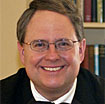Commentary on Mark 5:1-20
The second, longest, and most complex of this Gospel’s narrated exorcisms (see also Mark 1:21-128; 7:24-30; 9:14-29), Mark 5:1-20 is a tale of terror.
Jesus encounters a demoniac who horrifies his neighbors by howling among tombs (verses 2-3a, 5a), commandeered by diabolical powers that provoke him to appalling self-abuse, impossible to restrain (verses 3b-4, 5b). For Jewish listeners other details reek of religious impurity. In the Levitical tradition (Leviticus 22:4b-6a; 11:7-8; Numbers 5:2; 6:6; 9:6) contact with corpses defiles. More pointedly, “[those] who sit inside tombs, and spend the night in secret places, who eat swine’s flesh” (Isaiah 65:4; see Leviticus 11:7-8; Mark 5:11) typify a stubborn nation that rebels against the LORD’S holiness.
The demon’s name, “Legion” (Mark 5:9), referring to a Roman regiment of six thousand soldiers, is at once a petrifying depiction of this sufferer’s trauma and a reminder of Israel’s oppression by pagan colonials. Although the precise location of this episode has long been disputed (see also “Gadara”: Matthew 8:28; “Gergesa”: some manuscripts of Luke 8:26), Mark’s identification of the Decapolis (5:20) specifies a federation of ten, equally profane Gentile cities (Pliny’s first-century C.E Natural History 5.16, 74). Drenched in vilest degradation, menaced and menacing, the victim in Mark 5:2-5 is possessed by abominable forces of such magnitude as to defy any cure.
Unlike disobedient Israel, insisting that the LORD keep his distance from them (Isaiah 6:5), the man with the unclean spirit runs to Jesus and kneels before him (Mark 5:6). The demoniac’s condition is consonant with what modern psychiatry might diagnose as multiple personality disorder: he simultaneously submits to Jesus while holding him at bay (Mark 5:6-7a), confusing healing with torment (verse 7b), referring to himself in both the first-person singular (verses 7, 8) and plural (verses 9, 12). While, in Isaiah, the LORD promises to punish an idolatrous Israel (65:5a-10), Jesus receives this hideously tormented figure (Mark 5:2, 8-13a). As in1:23-25, a contest ensues between unclean spirit and its exorcist (5:7-9); as in 1:26, Jesus vanquishes the demons (5:10), who bargain for a measure of preservation by transferal into other creatures (verse 12). Jesus accedes in an equivocal way: at their begging (parekalsen) the demons are driven into thousands of unclean pigs, which thunderously hurl themselves into chaotic waters that drown both hosts and parasites (verse 13). Observant Jews might cheer such a spectacle. Having just lost their livelihood, Gentile herdsmen might be less sanguine: they fast report, throughout town and country, what’s just happened (verses 14a, 16).
Here the preacher might pause and ask, “How far I am prepared to follow Mark’s belief in the demonic?” We are sophisticated women and men, as are our parishioners. We can Google dissociative and obsessive-compulsive disorders, varieties of self-mutilation, and manifold chemical addictions, then cluck our tongues at scripture’s primitive explanations. Before mounting our high horses, we might ask just how much farther the American Psychiatric Association’s DSM carries us. Diagnostic interpretations vary in every era, but a mysterious residuum always remains. Over the course of a pastor’s life, or as recent as one’s glance at this morning’s news, an X-factor of ravaging evil is not so easily dismissed.
We’ve witnessed its ghastly overpowering of persons, cliques, gangs, and so-called civilized Christian nations that facilely justify daily bigotry and homicide, even the extermination of entire ethnic populations. The first step in capitulation to diabolism is our refusal to see it. The first step in resistance is our embrace of the Lord who masters it. To ask for the coming of our heavenly Father’s kingdom is to repel the reign of the Evil One. For what else do we pray when begging for deliverance from evil?
Returning to Mark 5:15-20 — Act II of this Sunday’s playlet — we might expect the townsfolk and villagers to celebrate Jesus’ treatment of the untreatable, and the one treated to join Jesus’ entourage with open arms. None of this happens. “They came to Jesus and saw the demoniac sitting there, clothed and in his right mind, … and they were afraid” (5:15). Exactly what they fear is unexpressed, though by now in Mark we’ve learned that fear is the opposite of faith (4:40-41). Here we have a curious case of anti-evangelism: eyewitness messengers report what they have seen Jesus do (5:16), whose proof is as plain as day (verse 15), and the listeners neither repent nor revel but start begging (parakalein) Jesus to get out of town (verse 17). He complies (verse 18a). “Pay attention to what you hear. … For to those who have, more will be given; and from those who have nothing, even what they have will be taken away” (4:24-25).
The one who was cured begs (parekalei) Jesus to accompany him: a primary qualification for discipleship (3:14). Now it is Jesus’ turn to refuse (5:19a), but not without giving the man a mandate: to return home and tell his friends how much the Lord has done for him (5:19b). The man obeys, and then some: he preaches (see 3:14), not merely at home, but throughout the Decapolis, what Jesus had done for him (5:20a). That comment adds another layer of ambiguity: in Mark “the Lord” can refer either to God (12:11, 29-30, 36; 13:20) or to Jesus (1:3; 2:28; 7:28; 11:3, 9; 12:37; 13:35). “[A]nd everyone was amazed” (5:20): a notch above repudiation (verse 17), perhaps, but not tantamount to faith (see 1:27; 12:17; 15:5).
To point to Jesus as the calm center in a cyclone of terror (Mark 5:6-9, 13, 15), who authorizes proclamation of the Lord’s merciful healing amid chaos and rejection (verse 19), may be the very thing a congregation needs to hear this Sunday. Beware, however, of sandpapering Mark’s rough edges. The cure may carry adverse side-effects (verses 13b, 16b). Many beg Jesus; their requests are denied (verse 19a) or granted with unpredictable results (verses 12-13). To be so affronted by Jesus that we drive him away (verses 17-18a) may be the greatest terror of all. His gospel does not coerce acceptance. He’ll not stay where he is unwanted.
PRAYER OF THE DAY
Jesus healer of mind and body, we sometimes suffer at the hands of physical, mental, and spiritual ailments. Quiet our minds, still our hearts, and empower our bodies so that we may be whole and healed. Amen.
HYMNS
Be not afraid ELW 388, GG 243
Listen, God is calling ELW 513, GG 456, TFF 130
Send me, Lord ELW 809, GG 746, NCH 360, UMH 497, TFF 244/245
CHORAL
Fix me Jesus, Hall Johnson


January 26, 2020